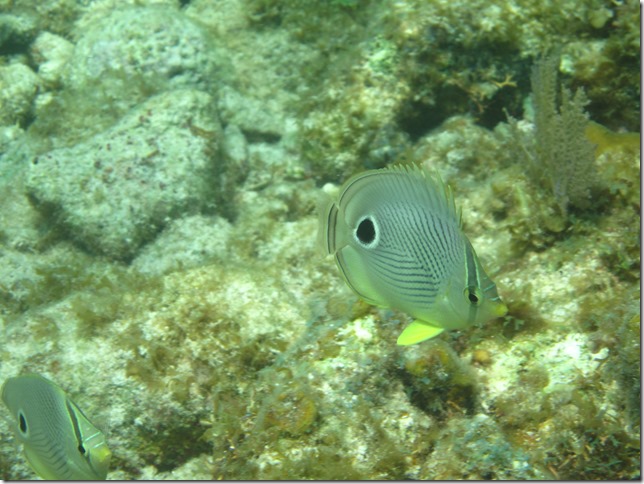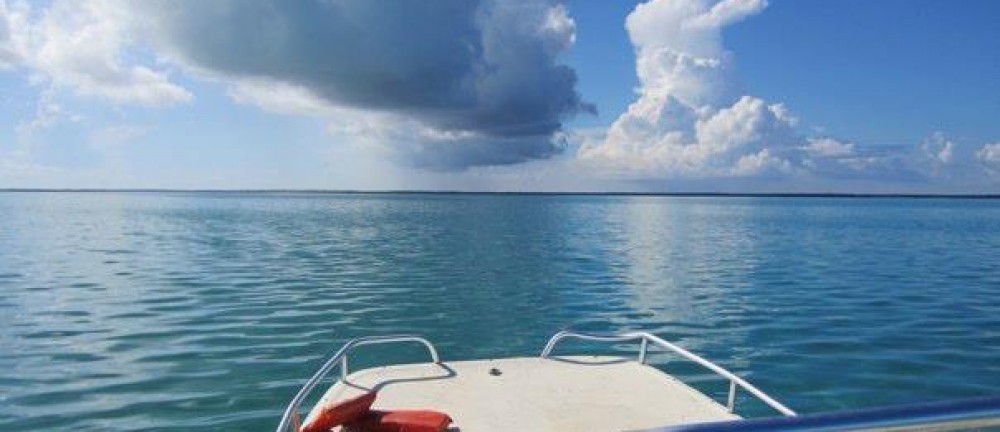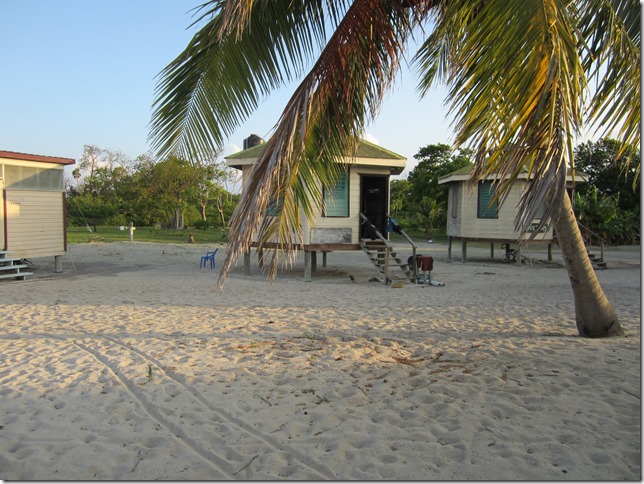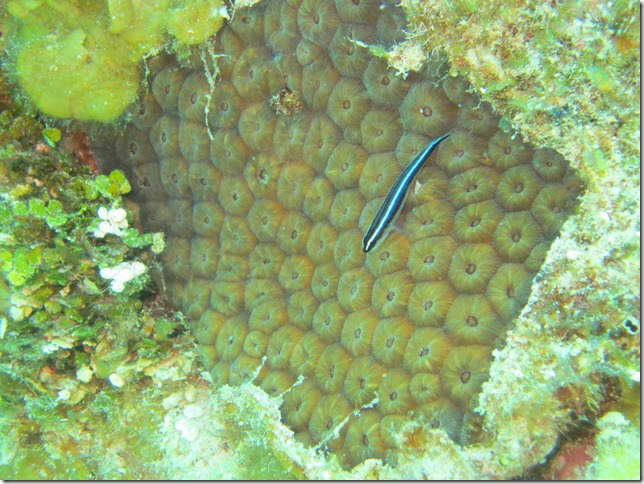Well after just 15 busy days, filled with diving (40), lionfish dissections (~250 between the four of us), 1 lionfish sting (to yours truly), science, and providing a food source for the local mosquito and sand flea populations, I’ve made it back to Texas, my new home for the next 2 years.
In Belize we stayed on Turneffe Atoll at the University of Belize’s Calabash Caye Field Station.
My primary goal while there was to start to get a feel for the type of research projects I could do for my Master’s thesis. In addition to that we gathered data and performed experiments for a few other studies. One set of these studies is continuing some of the research my advisor was performing about 10 years ago (long before the lionfish made it to Belize) looking at interconnectedness of fish from different parts of the Mesoamerican Caribbean. The part of that research we could do while in the field involved counting  various key species of fish recruits (new fish leaving the larval phase and landing on the reef). We also collected two different species the bicolor
various key species of fish recruits (new fish leaving the larval phase and landing on the reef). We also collected two different species the bicolor 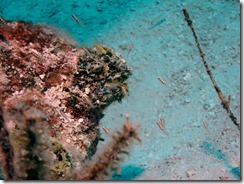 damselfish (Stegastes partitus right) and the masked/glass goby species complex (Coryphopterous persomatus/hyalinus it’s impossible to tell these species apart in the field so most people just lump them together. left). Why these two species? Well for one they are both super abundant on the reefs so its possible to remove some of them without impacting the local populations. Another reason is that they aren’t used for any economic purposes, so removing them isn’t taking them away from a fisherman who needs them to make money. Lastly they are super easy to catch. The masked/glass goby occurs in big clouds all over the reef so you can basically just scoop them up in an aquarium net and catch a whole bunch.
damselfish (Stegastes partitus right) and the masked/glass goby species complex (Coryphopterous persomatus/hyalinus it’s impossible to tell these species apart in the field so most people just lump them together. left). Why these two species? Well for one they are both super abundant on the reefs so its possible to remove some of them without impacting the local populations. Another reason is that they aren’t used for any economic purposes, so removing them isn’t taking them away from a fisherman who needs them to make money. Lastly they are super easy to catch. The masked/glass goby occurs in big clouds all over the reef so you can basically just scoop them up in an aquarium net and catch a whole bunch.
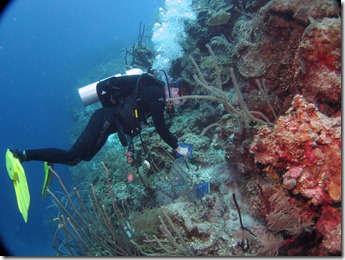 The bicolor damsel, like most damselfish is quite territorial so they tend to stay in the same place on the reef where you can spray them with clove oil (basically a fish anaesthesia made from cloves, just like what you might cook with, and ethanol). The clove oil slows the fish down a bit so you can catch them.
The bicolor damsel, like most damselfish is quite territorial so they tend to stay in the same place on the reef where you can spray them with clove oil (basically a fish anaesthesia made from cloves, just like what you might cook with, and ethanol). The clove oil slows the fish down a bit so you can catch them.
Of course we also collected lionfish from our sites for our research (and just doing a good  deed!) We used two basic methods to do this. One uses two hand nets basically exactly the same as in the above picture but replace the gobies with a lionfish. The other was your basic pole spear of science. The choice really just came to how big the fish was (small fish are much harder to hit with a spear). Using the nets you would then carefully remove the lionfish from the net and put it into the collection bag. With the spears we built PVC
deed!) We used two basic methods to do this. One uses two hand nets basically exactly the same as in the above picture but replace the gobies with a lionfish. The other was your basic pole spear of science. The choice really just came to how big the fish was (small fish are much harder to hit with a spear). Using the nets you would then carefully remove the lionfish from the net and put it into the collection bag. With the spears we built PVC containment tubes so you wouldn’t have to handle the fish at all to minimize stings (and it was a great success since only I was stung and that only happened once!).
containment tubes so you wouldn’t have to handle the fish at all to minimize stings (and it was a great success since only I was stung and that only happened once!).
Once we gathered all of the data and fish we needed it was time to go back to the lab to perform dissections and preserve everything. First things first we dissected the lionfish getting all their length and weight measurements and looking to see what they had been eating by cutting open 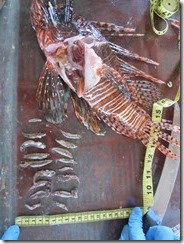 their stomach. This one had 16 fish in its stomach, and that’s not even the most we saw! We preserved some of these fish in ethanol (particularly when we found either of our other study species, they seem to like the goby) so that back in Texas we can try to do some genetic and otolith work on them for another study (more on that in a future post). We also removed the two sagittal otoliths (calcium deposits in the brain that act as a balance organ and can be used to determine age of the fish and with some cool chemical techniques determine the point of origin of new recruits). Because the gobies and damselfish we collected are so small (less than 2.5cm) we preserved the whole fish in ethanol to bring back to the lab in Texas where we have some nicer equipment for removing the otoliths (by nicer I just mean a dissecting microscope). With all of the fish we collected lionfish, damselfish, and gobies we took a fin clip to preserve for DNA work back in Texas. There will be more on the otolith and DNA work in the future.
their stomach. This one had 16 fish in its stomach, and that’s not even the most we saw! We preserved some of these fish in ethanol (particularly when we found either of our other study species, they seem to like the goby) so that back in Texas we can try to do some genetic and otolith work on them for another study (more on that in a future post). We also removed the two sagittal otoliths (calcium deposits in the brain that act as a balance organ and can be used to determine age of the fish and with some cool chemical techniques determine the point of origin of new recruits). Because the gobies and damselfish we collected are so small (less than 2.5cm) we preserved the whole fish in ethanol to bring back to the lab in Texas where we have some nicer equipment for removing the otoliths (by nicer I just mean a dissecting microscope). With all of the fish we collected lionfish, damselfish, and gobies we took a fin clip to preserve for DNA work back in Texas. There will be more on the otolith and DNA work in the future.
And that’s basically what we did in Belize. Here are a few miscellaneous pictures I took on some of the dives unrelated to the research and one of the lab group doing our safety stop, and no my hair isn’t usually that in the way while diving!
Lionfish hunting a fairy basslet
Big/old barrel sponge with some creole wrasse and sunshinefish around it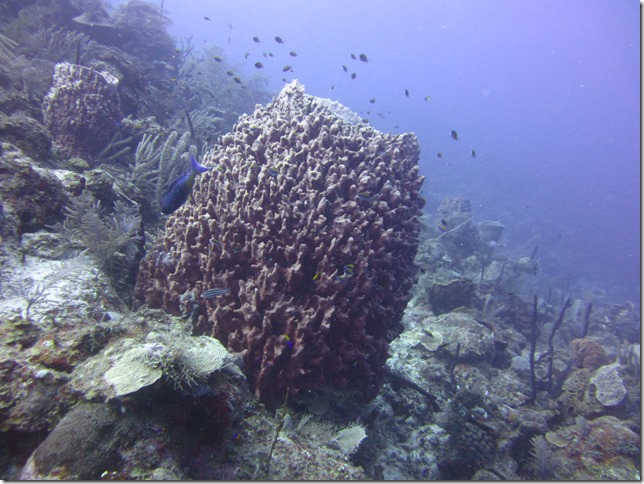
Part of a large school of black jacks
Sponges and some coral with blue chromis
Yellowhead jawfish checking to see if the coast is clear
Pair of four-eye butterflyfish. I imagine the one in the back saying “wait up honey” since they form mated pairs